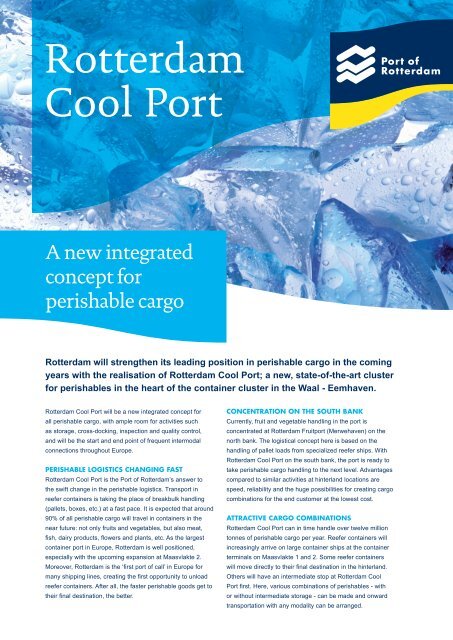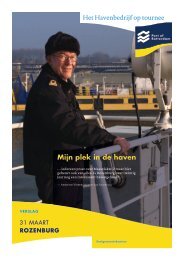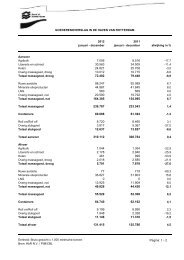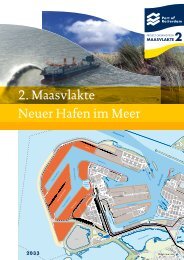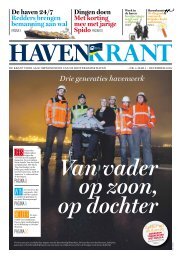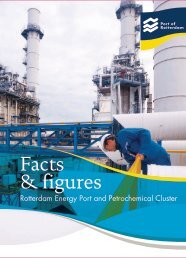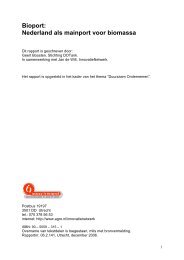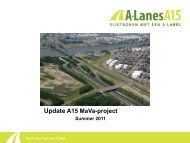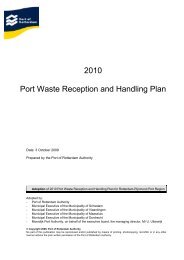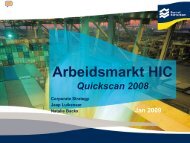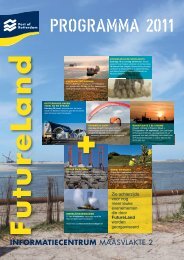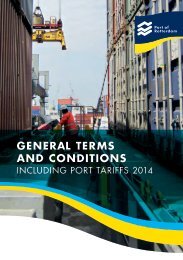Factsheet 'Rotterdam Cool Port' - Port of Rotterdam
Factsheet 'Rotterdam Cool Port' - Port of Rotterdam
Factsheet 'Rotterdam Cool Port' - Port of Rotterdam
You also want an ePaper? Increase the reach of your titles
YUMPU automatically turns print PDFs into web optimized ePapers that Google loves.
<strong>Rotterdam</strong><br />
<strong>Cool</strong> <strong>Port</strong><br />
A new integrated<br />
concept for<br />
perishable cargo<br />
<strong>Rotterdam</strong> will strengthen its leading position in perishable cargo in the coming<br />
years with the realisation <strong>of</strong> <strong>Rotterdam</strong> <strong>Cool</strong> <strong>Port</strong>; a new, state-<strong>of</strong>-the-art cluster<br />
for perishables in the heart <strong>of</strong> the container cluster in the Waal - Eemhaven.<br />
<strong>Rotterdam</strong> <strong>Cool</strong> <strong>Port</strong> will be a new integrated concept for<br />
all perishable cargo, with ample room for activities such<br />
as storage, cross-docking, inspection and quality control,<br />
and will be the start and end point <strong>of</strong> frequent intermodal<br />
connections throughout Europe.<br />
PERISHABLE LOGISTICS CHANGING FAST<br />
<strong>Rotterdam</strong> <strong>Cool</strong> <strong>Port</strong> is the <strong>Port</strong> <strong>of</strong> <strong>Rotterdam</strong>’s answer to<br />
the swift change in the perishable logistics. Transport in<br />
reefer containers is taking the place <strong>of</strong> breakbulk handling<br />
(pallets, boxes, etc.) at a fast pace. It is expected that around<br />
90% <strong>of</strong> all perishable cargo will travel in containers in the<br />
near future: not only fruits and vegetables, but also meat,<br />
fi sh, dairy products, fl owers and plants, etc. As the largest<br />
container port in Europe, <strong>Rotterdam</strong> is well positioned,<br />
especially with the upcoming expansion at Maasvlakte 2.<br />
Moreover, <strong>Rotterdam</strong> is the ‘fi rst port <strong>of</strong> call’ in Europe for<br />
many shipping lines, creating the fi rst opportunity to unload<br />
reefer containers. After all, the faster perishable goods get to<br />
their fi nal destination, the better.<br />
CONCENTRATION ON THE SOUTH BANK<br />
Currently, fruit and vegetable handling in the port is<br />
concentrated at <strong>Rotterdam</strong> Fruitport (Merwehaven) on the<br />
north bank. The logistical concept here is based on the<br />
handling <strong>of</strong> pallet loads from specialized reefer ships. With<br />
<strong>Rotterdam</strong> <strong>Cool</strong> <strong>Port</strong> on the south bank, the port is ready to<br />
take perishable cargo handling to the next level. Advantages<br />
compared to similar activities at hinterland locations are<br />
speed, reliability and the huge possibilities for creating cargo<br />
combinations for the end customer at the lowest cost.<br />
ATTRACTIVE CARGO COMBINATIONS<br />
<strong>Rotterdam</strong> <strong>Cool</strong> <strong>Port</strong> can in time handle over twelve million<br />
tonnes <strong>of</strong> perishable cargo per year. Reefer containers will<br />
increasingly arrive on large container ships at the container<br />
terminals on Maasvlakte 1 and 2. Some reefer containers<br />
will move directly to their fi nal destination in the hinterland.<br />
Others will have an intermediate stop at <strong>Rotterdam</strong> <strong>Cool</strong><br />
<strong>Port</strong> fi rst. Here, various combinations <strong>of</strong> perishables - with<br />
or without intermediate storage - can be made and onward<br />
transportation with any modality can be arranged.
A new integrated concept for perishable cargo<br />
DEEP SEA<br />
HINTERLAND TRANSPORT (DIV)<br />
BARGE<br />
DEEP SEA<br />
SHORT SEA<br />
BARGE<br />
TRUCK<br />
RAIL<br />
CHOOSING INTERMODAL TRANSPORT<br />
A crucial part <strong>of</strong> <strong>Rotterdam</strong> <strong>Cool</strong> <strong>Port</strong> is the intermodal<br />
transport <strong>of</strong> perishable cargo. Trucks are making way for<br />
sustainable transport by inland shipping and railway, with<br />
the port as a starting point. An inland shipping shuttle will<br />
maintain a continuous connection between the container<br />
terminals on the Maasvlakte and <strong>Rotterdam</strong> <strong>Cool</strong> <strong>Port</strong>,<br />
which is located about 30 kilometres further inland. For<br />
onward transport into Europe the aim is to increasingly use<br />
<strong>Rotterdam</strong>’s excellent hinterland connections by inland<br />
shipping and rail. Moreover, the Waal - Eemhaven area<br />
includes the Rail Service Center <strong>Rotterdam</strong>: the start and<br />
end point <strong>of</strong> dozens <strong>of</strong> train shuttles per day.<br />
IMPORTANT ROLE FOR SHORT SEA<br />
Shortsea is also destined to play an important role in<br />
<strong>Rotterdam</strong> <strong>Cool</strong> <strong>Port</strong>. For now, most <strong>of</strong> the vegetables and<br />
(citrus) fruits cultivated in southern Europe are transported to<br />
Western Europe by road. It is anticipated that the increasing<br />
obstacles for road transport and the growing attention for<br />
sustainability will lead to a cargo fl ow switch to shortsea in<br />
the future. As Europe’s number 1 shortsea port, <strong>Rotterdam</strong><br />
has excellent credentials for this purpose. <strong>Rotterdam</strong><br />
<strong>Cool</strong> <strong>Port</strong> is planned in the same area where the shortsea<br />
terminals are concentrated. Thanks to the many departures<br />
that take place from this location, it will be simple to transport<br />
perishable cargo by sea to other European countries (UK,<br />
Ireland and Scandinavia) via <strong>Rotterdam</strong> <strong>Cool</strong> <strong>Port</strong>. In<br />
addition, attractive cargo combinations are made possible<br />
with the export <strong>of</strong> our own Dutch fresh produce.<br />
START IN 2015<br />
The development <strong>of</strong> <strong>Rotterdam</strong> <strong>Cool</strong> <strong>Port</strong> is a joint initiative<br />
<strong>of</strong> the <strong>Port</strong> <strong>of</strong> <strong>Rotterdam</strong> Authority and key players in the<br />
perishables market. The goal is to have the fi rst perishable<br />
cargo make its journey via <strong>Rotterdam</strong> <strong>Cool</strong> <strong>Port</strong> in 2015.<br />
201105ID-FS019-E<br />
PORT OF ROTTERDAM AUTHORITY<br />
The aim <strong>of</strong> the <strong>Port</strong> <strong>of</strong> <strong>Rotterdam</strong> Authority is to enhance the port <strong>of</strong><br />
<strong>Rotterdam</strong>’s competitive position as a logistics hub and world-class<br />
industrial complex. Not only in terms <strong>of</strong> size, but also quality.<br />
The core tasks <strong>of</strong> the <strong>Port</strong> Authority are to develop, manage and<br />
run the port in a sustainable way and to maintain a speedy and safe<br />
service for shipping.<br />
© <strong>Port</strong> <strong>of</strong> <strong>Rotterdam</strong> Authority • Containers, Breakbulk & Logistics (0811/E)<br />
FOR MORE INFORMATION, PLEASE CONTACT<br />
<strong>Port</strong> <strong>of</strong> <strong>Rotterdam</strong> Authority<br />
P.O. Box 6622, 3002 AP<br />
<strong>Rotterdam</strong>, The Netherlands<br />
T + 31 (0)10 252 12 58<br />
F + 31 (0)10 252 40 87<br />
E coolport@port<strong>of</strong>rotterdam.com<br />
I www.port<strong>of</strong>rotterdam.com


